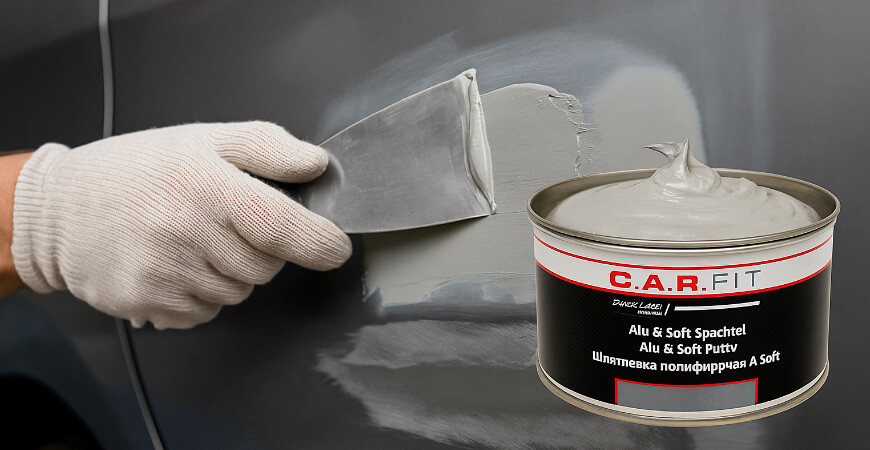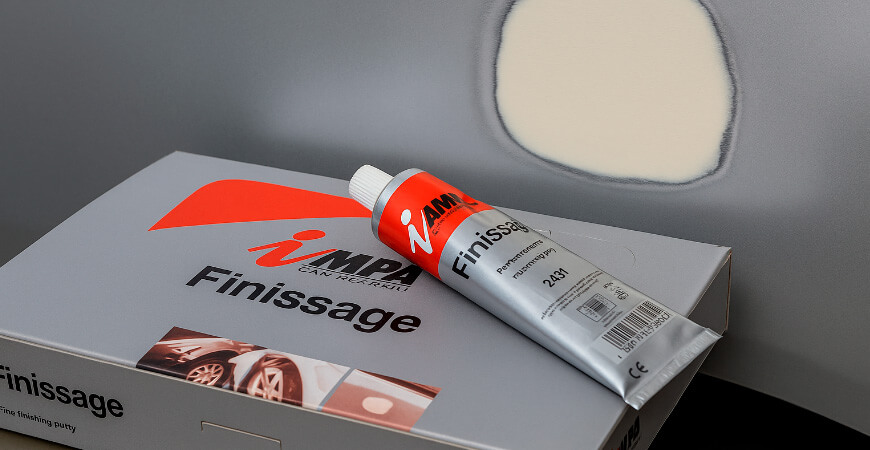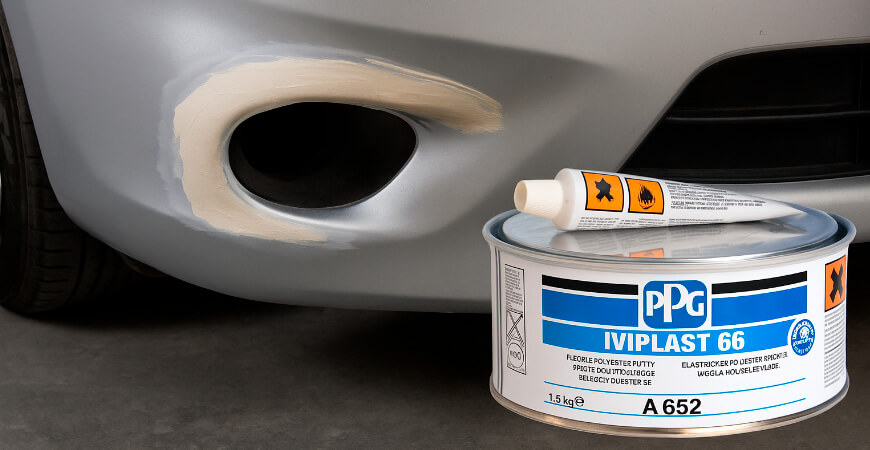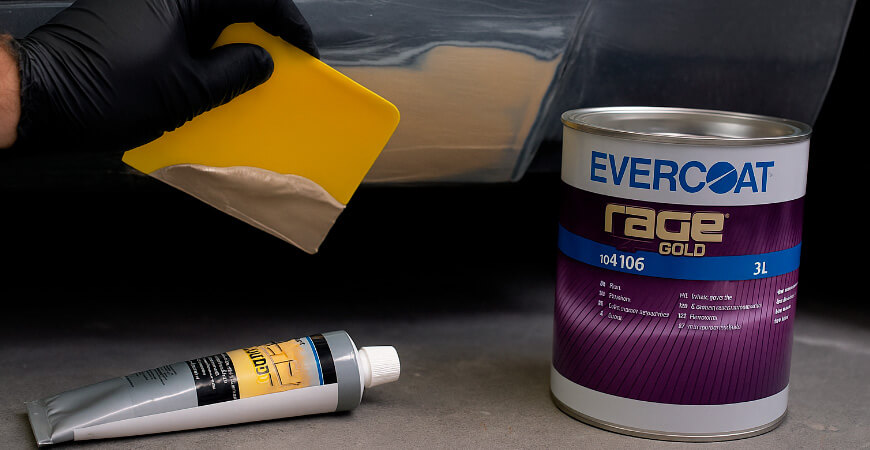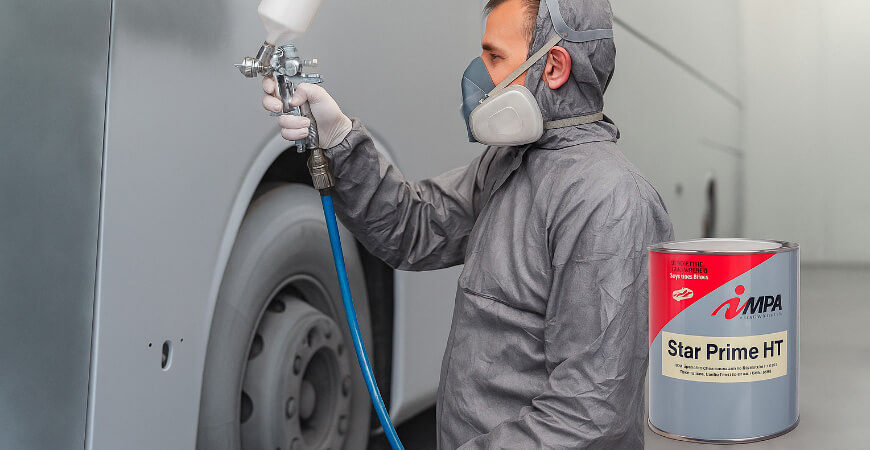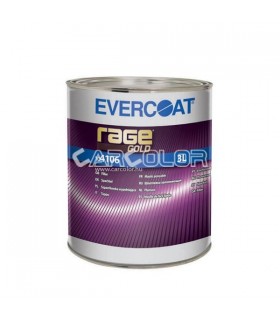Comprehensive Guide to Automotive Body Fillers – Types, Uses & Expert Tips
One of the most essential materials in body repair and car painting is properly selected body filler. Whether it's a dent, scratch, crack, or surface unevenness, the type of filler used determines the durability of the repair and the quality of the final paint finish. In this comprehensive guide, we present the most commonly used automotive body fillers – aluminum filler, spot putty, plastic repair filler, soft filler, spray filler, and fiberglass filler – detailing their advantages, disadvantages, and providing advice on when to use each type. The article contains practical tips useful for professionals and home users alike.
In this article, we cover...
Why Are Automotive Body Fillers Important?
Automotive body fillers (also known as putties) play a crucial role in body repair, providing high-quality, durable solutions for surface imperfections on vehicles. Selecting the correct filler significantly improves the efficiency of the repair process and contributes to a flawless appearance. Body filler is generally a two-component material (except some specific types like spot putty) designed to fill and smooth out dents, scratches, cracks, and uneven surfaces, creating an even, smooth surface for painting. Applying filler is an important preparatory step: after application, the filler hardens and becomes sandable, shaping the repaired area's final form.
A wide variety of fillers is available for different repair tasks – from fine surface leveling to filling larger damages, each task has a specialized product. Below, we introduce the six most commonly used filler types: aluminum filler, spot putty, plastic repair filler, soft (fine) filler, spray filler, and fiberglass filler. We detail their properties, usage areas, and provide practical advice on when and how to use each. These products are produced by renowned automotive brands like the Sherwin-Williams group (Debeer, Valspar, Prospray, Spralac), PPG, C.A.R. Fit, Impa, Evercoat, Novol, 3M, 4CR, Carsystem, and more, ensuring everyone, from professional body shops to hobbyists, finds the right product. In the following chapters, we'll thoroughly review each filler type's characteristics and applications.
Aluminum Filler
Aluminum filler is a two-component polyester filler mixed with fine aluminum powder. This composition results in a filler with high strength and excellent adhesion properties, specifically developed for heavy repairs and surfaces subjected to extreme stress. The aluminum additive enhances mechanical resistance and heat tolerance, making this filler ideal for repairing parts exposed to high temperatures, vibrations, or tension, such as hoods or fender edges. Aluminum filler is also noted for its rust resistance – it does not absorb moisture, thus preventing corrosion reoccurrence on repaired surfaces.
When to use it? Choose aluminum filler when the repaired part demands long-term strength. It's particularly suitable for extensive body damage, heavily stressed areas (door edges, pillars, thresholds), or even aluminum body panels. Due to its aluminum content, this filler expands and conducts heat similarly to metal, creating a stable bond. It's also used in challenging repairs where other fillers might crack or detach. Aluminum filler can be used directly for dent or crack filling, often applied after a fiberglass base layer for comprehensive surface leveling.
How to use it? Using aluminum filler is similar to conventional polyester body fillers. Mix the resin with the appropriate amount of catalyst (usually about 2-3% hardener to filler weight). Apply evenly onto a cleaned, sanded and degreased metal surface using a spatula. Avoid applying excessively thick layers in one go; build up the required thickness in thin layers. Drying and curing time is rapid (a few minutes up to half an hour depending on temperature), after which sanding is recommended. Aluminum filler is easily sandable, leveling itself nicely, and does not require specialized tools. After complete curing and sanding, always apply a primer surfacer (filler primer) before painting, as polyester filler is porous and cannot be painted directly.
Spot Putty (Pore Filler)
The term "spot" (also known as pore filler) indicates that this filler is used to address small imperfections or tiny uneven areas left after major repairs. It is usually a single-component product, like the tube-based spot putty manufactured by brands like 3M or Impa, which air-dries and does not require a separate hardener component. Single-component nitrocellulose or acrylic-based spot putties offer the advantage of rapid drying, excellent adhesion, and easy sanding. Their fine particle size enables achieving an exceptionally smooth surface on the repaired area.
When to use it? Spot putty is typically applied in the final phase of repairs, after larger defects have been corrected using universal or soft fillers. Once small pinholes, scratches, or minor imperfections remain after primer application, spot putty helps eliminate these final blemishes. Using spot putty is especially important before quality painting, as even minor imperfections become more noticeable after painting—spot putty ensures these small scratches and pores are completely smoothened. Both professionals and hobbyists frequently use spot putty on small areas, such as filling stone chips, minor parking scratches, or even for woodworking where similar smooth surfaces are desired.
How to use it? Spot putty typically comes as a ready-to-use paste in a tube or container. Before application, thoroughly clean and lightly sand (fine grit sandpaper) the surface. Apply a thin layer of spot putty to the small imperfections using a spatula or even your finger (wearing a rubber glove). Slightly overfill the imperfections as the product shrinks slightly upon drying. Due to its rapid drying time (typically sandable within 20-30 minutes), there is minimal waiting before sanding. For deeper pores, apply several thin layers, letting each layer dry fully before adding the next. Once dry, sand the area smooth using fine grit sandpaper (around P320-P400). A significant advantage of spot putty is that after sanding, it can be directly painted or primed without an additional filler primer, as it’s applied in very thin layers. However, for larger areas, applying a thin layer of primer surfacer can ensure a uniform, flawless result.
Plastic Repair Filler
Plastic repair filler, specifically developed for plastic body parts (bumpers, spoilers, mirror housings), is a specialized polyester filler incorporating flexible additives. These additives give the filler the necessary flexibility for plastic repairs. Conventional fillers harden rigidly, risking cracks or separation on flexible plastic—whereas plastic filler is impact and vibration-resistant, adjusting to plastic movement without cracking. It provides excellent adhesion to automotive plastics (PP, PUR, ABS), ensuring durable repairs. Quality plastic fillers resist solvents and chemicals and do not damage the plastic substrate after curing. They flow easily into scratches and cracks, offering a smooth sanding experience. Crucially, these products are compatible with typical paint systems—primers and topcoats can be applied without causing reactions or bleed-through.
When to use it? Always use plastic filler instead of traditional metal filler when repairing plastic body parts. Common examples include filling cracks or scratches in bumpers, smoothing scuffs on moldings, or reshaping broken plastic attachment points. Due to its flexibility, plastic filler won't chip or crack under impact. Usually, the plastic surface requires initial coarse sanding (P80-P120) and repairs with plastic adhesives or welding for strength. Plastic filler is also ideal for correcting production imperfections or scratches on plastic surfaces before painting.
How to use it? Proper surface preparation is crucial before applying plastic repair filler. The plastic should be clean, free from grease and silicone—use plastic cleaners (anti-silicone) and anti-static cloths for dust removal. Due to smooth plastic surfaces’ difficulty adhering, sand (P120-P180 grit) the area, possibly applying a plastic primer or adhesion promoter beforehand. Mix the two-component plastic filler with the provided hardener according to the manufacturer's instructions. Apply thin layers using a spatula, pressing firmly into scratches or cracks. The filler is somewhat flexible, so shape it carefully. Let fully cure (~20 minutes). After curing, plastic filler sands easily, starting with medium (P180-P240), then fine (P320-P400) grit paper for smoothness. Finally, apply a plastic-compatible primer surfacer, then paint. Properly prepared, the repaired area will be strong, durable, and resistant to impacts, vibrations, and weather, matching the original plastic.
Soft Filler (Fine Filler)
Soft filler (fine filler) is a type of universal polyester body filler used widely in automotive repairs. It features an exceptionally fine-grained texture, is lightweight, and has a creamy consistency. After curing, soft fillers are non-porous and easily sandable, helping achieve an exceptionally smooth finish. Primarily designed to correct small dents, scratches, and minor imperfections, soft filler is ideal when extreme strength (e.g., fiberglass) or specialized properties (e.g., aluminum filler) are not required. Due to its fine texture, soft filler blends seamlessly into the surrounding surface, significantly reducing the risk of visible edges after painting. Often referred to as finishing filler, it is applied in thin layers after initial rough filling, ensuring perfect final smoothness.
When to use it? Soft filler is a great choice for general-purpose repairs, especially smaller damages. Typical scenarios include filling minor dents or deeper scratches before painting. Professionals commonly apply soft filler after using stronger types (fiberglass or aluminum) to perfect the surface smoothness before primer. It's also popular among DIY users because it's user-friendly and provides fast results. Soft filler doesn't replace primer surfacer (filler primer), but it's applied just before primer on sanded surfaces to eliminate minor imperfections.
How to use it? Application of soft filler follows general two-component polyester filler usage. Mix filler paste with around 2-3% hardener evenly. Ensure thorough mixing until the mass is uniform in color (the hardener is typically differently colored to aid mixing visibility). Apply evenly using a spatula, spreading thinly and smoothly. The soft filler has a creamy consistency, making it easy to spread, reducing sanding work later. Cure time averages 15-20 minutes, after which sanding begins. Start with medium grit (P120-P180), progressing to finer grits (P240-P320) and finishing around P400, blending the repaired area smoothly with the surroundings. Quality soft filler does not clog sandpaper, allowing rapid progress. Apply multiple thin layers if needed, sanding each after curing. Although it adheres well to metal, wood, and fiberglass, optimal results come from clean, sanded metal or primed surfaces. After sanding, apply a primer surfacer before painting. Popular premium soft filler products include Evercoat Rage Gold or Evercoat Rage Ultra, renowned for ease of sanding and excellent adhesion, able to fill imperfections up to 6mm thick without cracking.
Spray Filler
Spray filler is a specialized, sprayable filler used to quickly level large areas or complex-shaped surfaces. Unlike traditional spatula-applied fillers, spray fillers are applied using a spray gun or aerosol cans, dramatically speeding up coverage on large or complicated panels. Typically polyester-based, spray filler has a thinner consistency to pass through spray gun nozzles easily. It features high filling capability, effectively covering minor dents, scratches, and sanding marks across wide areas, creating a uniform, smooth base for painting. Spray filler layers are thicker than standard primer (filler primer), but thinner than traditional spatula fillers, serving as an intermediate solution.
When to use it? Use spray filler for large surfaces requiring minor surface corrections quickly. Ideal scenarios include entire doors or fenders with multiple minor imperfections or undulations. It’s especially useful for restoration projects or classic car repairs, smoothing surfaces repaired with lead or tin without manual work. Hobbyists benefit from aerosol spray fillers (e.g., Motip Spray Putty), suitable for small repairs or home applications, usually acrylic-based with corrosion inhibitors, applicable on metal or wood for minor smoothing. Note: Spray filler doesn't replace heavy filler; deep or large damages require fiberglass or soft filler as a base. Spray filler is primarily a fast, effective solution for fine leveling.
How to use it? For two-component spray filler, thoroughly mix filler with the hardener and load it into a spray gun. Follow manufacturer specifications for nozzle size (usually 1.8–2.5 mm) and air pressure settings suitable for the thick filler. Apply filler in crosswise layers, building 1-3 coats depending on desired thickness. Allow 5-10 minutes flash-off between layers. After application, let spray filler fully cure—accelerated by heat lamps or heat drying. Sand wet or dry, typically starting with medium (P240-P320) and finishing fine (P400-P600) for a smooth finish. Critically, spray filler must always be sealed with a suitable primer surfacer (filler primer) before applying topcoat paint. Avoid applying spray filler directly onto reactive primers (e.g., wash primer) as it may cause reactions. Proper layering (epoxy or 2K primer on metal, then spray filler, followed by 2K filler primer) ensures durable results.
Fiberglass Filler
Fiberglass filler is a specialized polyester body filler reinforced with small fiberglass strands. These fibers significantly enhance the filler's strength, making fiberglass filler one of the strongest and most durable options for automotive body repair. It’s specifically developed for repairs where standard fillers would be insufficient, such as filling large cracks, holes, or cut-outs in body panels. Once hardened, fiberglass filler is harder and tougher to sand than soft fillers, but it remains stable in challenging areas where other fillers might crack or deform. It offers excellent water and corrosion resistance, making it ideal for repairs on rust-prone areas. Fiberglass filler is versatile, suitable not only for automotive repairs but also for boats, water tanks, and composite materials.
When to use it? Apply fiberglass filler when dealing with structural damage such as holes or significant cracks. Commonly used to fill rust-caused holes or welded joints on car bodies, it provides strength and excellent adhesion. It's especially useful for repairing composite materials or fiberglass parts, commonly used in racing and tuning car bodies. Due to its rougher surface finish after sanding, fiberglass filler usually requires an additional layer of soft filler for achieving a perfectly smooth finish. Think of fiberglass filler as a structural filler layer, later refined with fine filler.
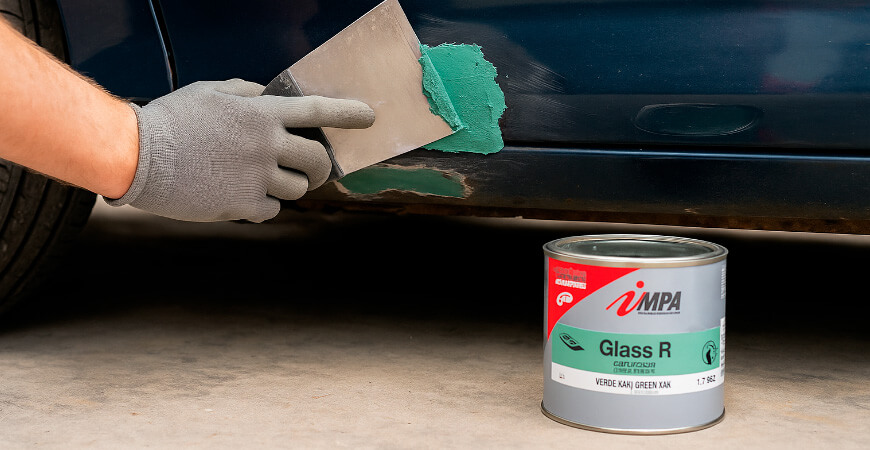
How to use it? Fiberglass filler is a two-component product, usually greenish or bluish due to the embedded fibers. Mix thoroughly with approximately 2% BPO hardener (usually red-colored) until uniform. Surface preparation is crucial: remove all rust, loose paint, and sand edges to bare metal. Creating a rough or drilled surface enhances adhesion. Apply filler firmly into holes or cracks using a spatula. For filling larger holes, support from behind with fiberglass mesh may be required. Apply in multiple thin layers for deeper repairs, allowing each layer to fully cure. After curing, fiberglass filler is quite hard; initial sanding with coarse grit paper (around P80) and power tools is recommended. Finish the surface with a finer soft filler to fill minor pores and sanding marks. Finally, always seal with a suitable primer surfacer (filler primer) before painting. Protective gear (dust mask, gloves) is advised due to fiberglass dust produced during sanding.
Tips for Achieving Professional Results
As we've reviewed, each filler type serves a unique role in automotive body repair. Success comes from selecting the correct filler for each specific task—fiberglass or aluminum for structural repairs, soft and spot putties for final smoothing, and plastic fillers for plastic components. Both professional painters and DIY enthusiasts can achieve exceptional results with these materials, available from top brands like 3M, PPG, Sherwin-Williams/DeBeer, Valspar, C.A.R. Fit, Impa, Evercoat, Novol, 4CR, and others. These quality fillers provide excellent adhesion, easy sanding, and compatibility with modern painting systems.
Here are some essential general tips for professional-quality results:
- Thorough preparation: Always apply filler to clean, dry, degreased, and sanded surfaces (P80-P120 grit) to ensure proper adhesion. For plastic surfaces, use adhesion promoters when needed.
- Proper mixing ratio: Follow the recommended hardener ratios (usually 2-3% hardener per filler volume). Incorrect mixing may lead to slow curing or brittleness.
- Layer thickness and number: Avoid thick single-layer application, as it may crack during drying. Apply filler in several thin layers, sanding between applications. Spot putty should be applied very thinly for micro repairs.
- Respect drying times: Wait until filler is fully cured before sanding. Early sanding may smear the filler, reducing surface quality. Extend curing time in cold conditions or use heat for faster curing.
- Progressive sanding: Start with coarse sandpaper (P80-P120), gradually progressing to finer grit (P180-P320), finishing around P400-P600 before primer surfacer. Proper sanding ensures no repair marks show through the topcoat.
- Primer surfacer application: Always finish repairs by sealing with primer surfacer. This prevents paint absorption and provides a smooth, uniform surface for topcoat application. Never paint directly onto filler.
- Safety and health: Always wear protective equipment (dust mask, gloves) when working with fillers. Dust, especially from fiberglass fillers, can be harmful. Ensure proper ventilation or dust extraction.
With proper selection and application, automotive body fillers enable seamless repairs, restoring damaged panels to factory smoothness. Follow these methods, and your repair will be durable, the paint finish flawless, significantly enhancing your vehicle's appearance, value, and lifespan. In summary: select the right filler, prepare surfaces meticulously, apply layers patiently, and always finalize repairs with primer surfacer—this approach guarantees professional results, whether in a home garage or professional workshop.


